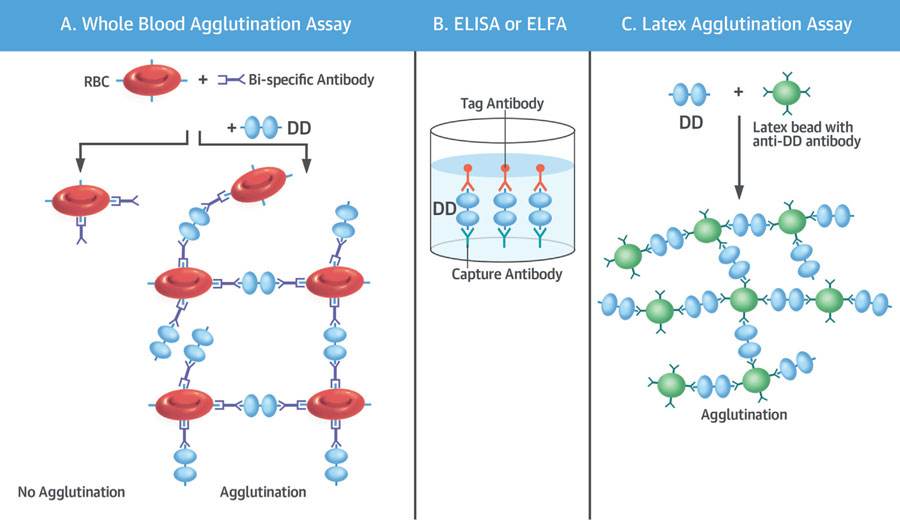Fibrin monomers in blood are cross-linked by activated factor X III, and then hydrolyzed by activated plasmin to produce a specific degradation product called "fibrin degradation product (FDP)." D-Dimer is the simplest FDP, and the increase in its mass concentration reflects the hypercoagulable state and secondary hyperfibrinolysis in vivo. Therefore, the concentration of D-Dimer is of great significance for the diagnosis, efficacy evaluation and prognosis judgment of thrombotic diseases.
Since the outbreak of COVID-19, with the deepening of the clinical manifestations and pathological understanding of the disease and the accumulation of diagnosis and treatment experience, severe patients with new coronary pneumonia can rapidly develop acute respiratory distress syndrome. Symptoms, septic shock, refractory metabolic acidosis, coagulation dysfunction, and multiple organ failure. D-dimer is elevated in patients with severe pneumonia.
Severely ill patients need to pay attention to the risk of venous thromboembolism (VTE) due to prolonged bed rest and abnormal coagulation function.
During the treatment process, it is necessary to monitor relevant indicators according to the condition, including myocardial markers, coagulation function, etc. Some patients may have increased myoglobin, some severe cases may see increased troponin, and in severe cases, D-dimer (D-Dimer) may be increased.

It can be seen that D-Dimer has complication-related monitoring significance in the progression of COVID-19, so how does it play a role in other diseases?
1. Venous thromboembolism
D-Dimer has been widely used in venous thromboembolism (VTE) related diseases, such as deep vein thrombosis (DVT) and pulmonary embolism (PE). A negative D-Dimer test can rule out DVT, and the D-Dimer concentration can also be used to predict the recurrence rate of VTE. The study found that the hazard ratio of VTE recurrence in the population with higher concentration was 4.1 times that of the population with normal concentration.
D-Dimer is also one of the detection indicators of PE. Its negative predictive value is very high, and its significance is to exclude acute pulmonary embolism, especially in patients with low suspicion. Therefore, for patients suspected of acute pulmonary embolism, ultrasonography of the deep veins of the lower extremities and D-Dimer examination should be combined.
2. Disseminated intravascular coagulation
Disseminated intravascular coagulation (DIC) is a clinical syndrome characterized by hemorrhage and microcirculatory failure on the basis of many diseases. The development process involves multiple systems such as coagulation, anticoagulation, and fibrinolysis . D-Dimer increased in the early stage of DIC formation, and its concentration continued to increase more than 10-fold as the disease progressed. Therefore, D-Dimer can be used as one of the main indicators for the early diagnosis and condition monitoring of DIC.
3. Aortic dissection
"Chinese expert consensus on the diagnosis and treatment of aortic dissection" pointed out that D-Dimer, as a routine laboratory test for aortic dissection (AD), is very important for the diagnosis and differential diagnosis of dissection. When the patient's D-Dimer rises rapidly, the possibility of being diagnosed as AD increases. Within 24 hours of onset, when D-Dimer reaches the critical value of 500 µg/L, its sensitivity for diagnosing acute AD is 100%, and its specificity is 67%, so it can be used as an exclusion index for the diagnosis of acute AD.
4. Atherosclerotic Cardiovascular Disease
Atherosclerotic cardiovascular disease is a heart disease caused by arteriosclerotic plaque, including ST-segment elevation acute myocardial infarction, non-ST-segment elevation acute myocardial infarction, and unstable angina. After plaque rupture, the necrotic core material in the plaque flows out, causing abnormal blood flow components, activation of the coagulation system, and increased D-Dimer concentration . Coronary heart disease patients with elevated D-Dimer may predict a higher risk of AMI and can be used as an indicator to observe the condition of ACS.
5. Thrombolytic therapy
Lawter's study found that various thrombolytic drugs can increase D-Dimer, and its concentration changes before and after thrombolysis can be used as an indicator for judging thrombolytic therapy. Its content rapidly increased to a peak value after thrombolysis, and fell back in a short time with significant improvement in clinical symptoms, indicating that the treatment was effective.
- The level of D-Dimer increased significantly 1 hour to 6 hours after thrombolysis for acute myocardial infarction and cerebral infarction
- During DVT thrombolysis, the D-Dimer peak usually occurs 24 hours or later


 Business card
Business card Chinese WeChat
Chinese WeChat English WeChat
English WeChat